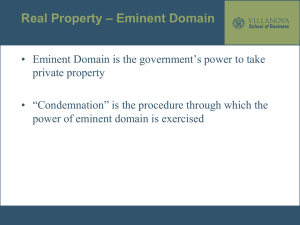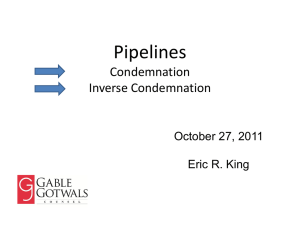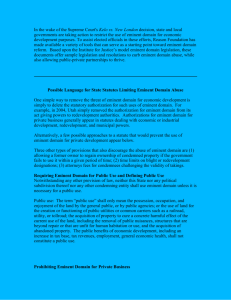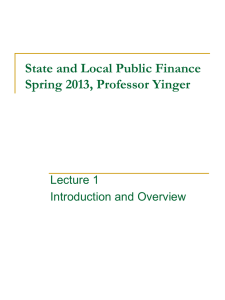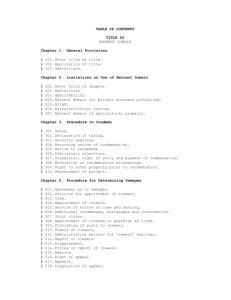The Use of Eminent Domain in Water Resources Management
advertisement
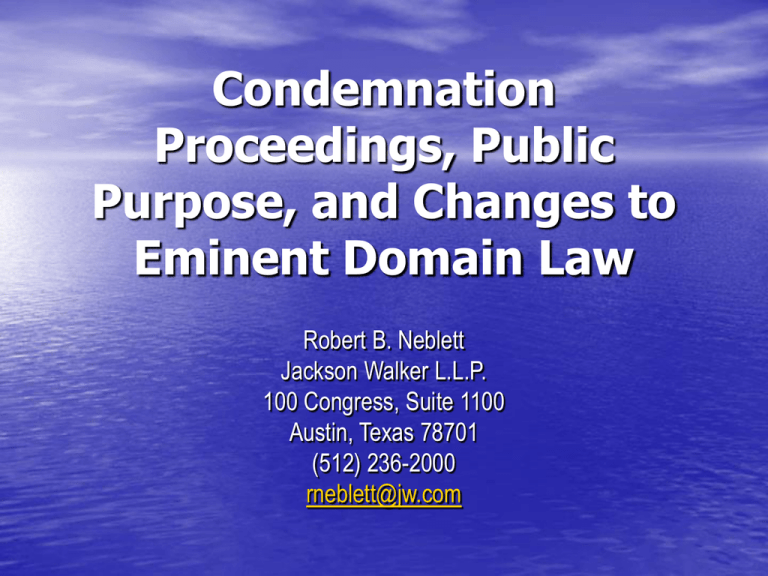
Condemnation Proceedings, Public Purpose, and Changes to Eminent Domain Law Robert B. Neblett Jackson Walker L.L.P. 100 Congress, Suite 1100 Austin, Texas 78701 (512) 236-2000 rneblett@jw.com Overview • What is eminent domain and who has the power to use it? • Limitations on the power of eminent domain • Recent Case Law and the Legislative Response • Issues to Consider as a Condemnor The Power of Eminent Domain • Stems from superior rights of the Crown • 5th Amendment of the United States Constitution • Article 1, Section 17 of the Texas Constitution Authority to Condemn • Vested in the Legislature • Article 16, section 59 of the Texas Constitution provides for the creation of “conservation and reclamation districts.” Authority to Condemn, (cont.) • Texas Water Code § 11.033 (Wagstaff Act) • “All political subdivisions of the state and constitutional governmental agencies exercising delegated legislative powers have the power of eminent domain to be exercised as provided by law for domestic, municipal, and manufacturing uses and for other purposes authorized by this code …” Water Code Section 49.222 “(a) A district or water supply corporation may acquire by condemnation any land, easements, or other property inside or outside the district boundaries, or the boundaries of the certificated service area for a water supply corporation, necessary for water . . .” Water Code 49.222, explained • Provides general eminent domain authority “inside or outside the district boundaries” for all general or special law districts. • Specifically prohibits condemnation to acquire groundwater or other water rights. • Special law districts may have broader powers according to their enabling legislation, including the power to condemn water rights. The Power to Condemn • Groundwater Conservation Districts • General Law Districts ―Municipal Utility Districts (MUDs) ―Special Utility Districts (SUDs) ―Fresh Water Supply Districts (FWSDs) • Special Law Districts Groundwater Conservation Districts • A general law district created under Chapter 36 of the Texas Water Code. • Has eminent domain power including fee simple acquisition, but does not have the power of eminent domain over water rights. See Tex. Water Code § 36.105. General Law Districts: MUDs, SUDs, WCIDs, FWSDs, etc. • General law districts are granted condemnation authority by Water Code § 49.222. • General law districts do not have the power of eminent domain over surface or groundwater. Special Law Districts • Created by special act of the legislature. • Numerous MUDs, SUDs, FWSDs and GWCDs have been created by special legislation. • Condemnation authority governed by § 49.222 unless broader power granted by enabling legislation. River Authorities • Feature an independent legislative authority that trumps the Water Code. • Have additional eminent domain powers, as granted by their enabling legislation, up to and including acquisition of fee simple title and condemnation of groundwater rights. Bottom Line, (cont.) • General law districts: no power to condemn water rights. • Generally, when any of these entities use their power to condemn it is for easements for pipelines, land for reservoirs, water or wastewater treatment facilities, and/or some form of drainage control. Public Use: The Constitutional Limitation of Eminent Domain • The Texas and U.S. Constitutions both limit the exercise of eminent domain power. • Must be for a “Public Use.” Liberal View of “Public Use” • Borden v. Trespalacios Rice and Irrigation Co. – Borden dealt with the taking in Matagorda County that was seemingly for the profit of private cotton and cattle interests. – Condemnees contended that condemnation was not for public use and therefore the condemnation was unlawful. – Court held that the condemnation was for a public use, even though it would have some private benefit. Public Necessity • A taking must be both for a public use, and necessary to achieve the declared public purpose. • However, the condemnor’s discretion to determine public necessity is nearly absolute absent fraud, or arbitrary and capricious behavior. Public Necessity, (cont.) • Malcomson Road Utility District v. Newsom – Private developers seeking property asked the District to condemn the portions of Newsom’s land that they had failed to purchase. – District Condemned Newsom’s land and Newsom appealed. – Court held that there was a fact issue as to whether the District reached its condemnation decisions arbitrarily and capriciously or by abusing its discretion. The Kelo Decision • New London, Connecticut utilized eminent domain to revitalize an economically distressed city. – Revitalization was projected to create 1,000 jobs – Create a State Park, build a marina and river walk – 300 million dollar Pfizer, Inc. research center • United States Supreme Court found that promoting economic development is a public use under the U.S. Constitution. Texas Legislature’s Response to Kelo Senate Bill 7 -TEX. GOV’T CODE § 2206.001 • Prevents the condemning of property for: – (1) the private benefit of a private party; – (2) a public purpose that is merely pretext to confer a private benefit on a private party; or – (3) purely economic development purposes Texas Legislature’s Response to Kelo Senate Bill 7 -TEX. GOV’T CODE § 2206.001(c) • The Act does not affect the authority of an entity authorized by law to take private property through the use of eminent domain for … water supply, wastewater, flood control, and drainage projects… Further Legislative Efforts Following Kelo • HB 1495 – Landowner’s Bill of Rights (2007) – Codified at § 21.0112 of the Property Code – http://www.oag.state.tx.us/agency/Landowners_billofrights.pdf – Amended by HB 2685 in 2009 • SB 11 – Production of Certain Information (2007) – Codified at § 21.024 of the Property Code – Requires Condemnor for “Critical Infrastructure” to produce certain information relating to the condemnation of the specific property for which information was requested Further Legislative Efforts Following Kelo • HB 51 & HJR 14 (2009) • Constitutional Amendment passed in November –Amends Art.1, Sec. 17 –Places restriction on condemnation for economic development within the Constitution Further Legislative Efforts Following Kelo • HB 51 & HJR 14 (2009) • Constitutional Amendment passed in November – Adds qualifying language that the taking, damage, or destruction must be for the ownership, use, and enjoyment of the property – Requires any new law (general, local or special) bestowing the power of eminent domain to receive a twothirds vote of both the House and Senate Further Legislative Efforts Following Kelo • HB 2006 (2007) & SB 18 (2009) – Neither bill has become law – Both bills would have defined public use to include the “possess use, and enjoy” language that is now a part of our Constitution – Would have required a governmental entity to authorize condemnation at a public meeting and by record vote – Would have allowed repurchase by landowner for price paid by condemnor (as opposed to current fair market value) – Would have slowed down condemnation process by requiring 20 days notice prior to hearing and prohibiting the scheduling of a commissioners hearing within 20 days from the appointment of commissioners – Would have required a bona fide offer and allowed for abatement of suit and recovery of fees if no bona fide offer was made. Further Legislative Efforts Following Kelo • SB 1023 (2009) – Would have added a requirement that public necessity must be stated in petition and proven by condemnor – Would have required the condemnor to pay attorneys fees, expert fees and cost if the commissioners returned an award greater than the condemnors’ final offer or, if the case was appealed, if the court returned a higher award than the commissioners Non-Kelo Legislation • SB 1253 (2009) – Repealed section 49.2205 of the Water Code – Water District and Water Supply Corporation right-of-way easement now cannot be used for wind (or any other) electric transmission line projects • SB 1254 (2009) – Would have limited Freshwater Utility Districts use of eminent domain to an area of 5 miles outside its boundaries without TCEQ approval – Would have limited the use of eminent domain to an area of 75 miles outside its boundaries even with TCEQ approval Public/Private Ventures after Malcomson and Constitutional Amendment • Hypothetical Question Raised: – A private water supply corporation with a water supply contacts a River Authority with the power to condemn and asks the River Authority to condemn for a water pipeline and then transfer the rights to the corporation. Can they do this? Public/Private Ventures, (cont.) • Answer: – Probably not, unless there is some public necessity for the River Authority to engage in the project in some way. It is the River Authorities board that is making the determination that the taking is for a public use and that it is necessary. Practical Considerations for Partnering under 49.227 • Public entity should participate in the project as much as possible in order to successfully fend off a challenge to the right to condemn. • Such efforts on the part of the public entity should include the following: Practical Considerations, (cont.) • Acquiring easements, including negotiation. • Owning easements and physical appurtenances of the project. • Acquiring/identifying customers to be served by the line. • Utilizing condemnation agreements that do not indemnify the District for opposing party’s attorney’s fees should the Court find no right to condemn. Regulatory Takings • Barshop v. Medina County Underground Water Conservation District – District and cattle interests challenged the act which created the Edwards Aquifer Authority as unconstitutional because it allowed the Edwards Aquifer Authority “to regulate groundwater withdrawals by well from the aquifer[.]” Barshop, (cont.) – Supreme Court dodged the issue of whether groundwater vested before or after it was captured by the landowner, instead upholding the constitutionality of the Act on the grounds that: – The Act affected the use of water, not title to it; – Even if plaintiffs were divested of a real property right, the state has condemnation power to do so; and – The act provided adequate due process. CONDEMNATION PROCESS • • • • • • • • Governed by Chapter 21 of the Texas Property Code Corporate Resolution Negotiations with Landowner File Suit Appointment of Special Commissioners Hearing by the Special Commissioners Damage Calculations by Special Commissioners Possession Pending Litigation Adequate Compensation • Fair Market Value • State v. Carpenter – “…all circumstances which tend to increase or diminish present market value” – But not “remote, speculative, or conjectural uses…not reflected in present market value” • Appraisal Approaches
